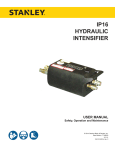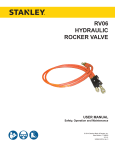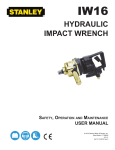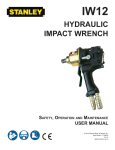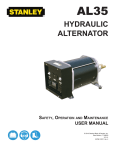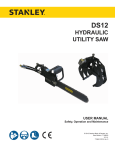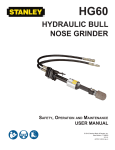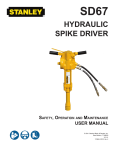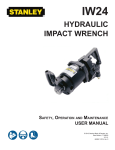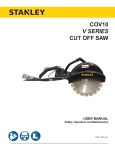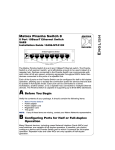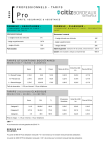Download HYDRAULIC INTENSIFIER - Stanley Hydraulic Tools
Transcript
IP16 HYDRAULIC INTENSIFIER Safety, Operation and Maintenance USER MANUAL © 2011 Stanley Black & Decker, Inc. New Britain, CT 06053 U.S.A. 10413 3/2011 Ver. 2 TABLE OF CONTENTS SAFETY SYMBOLS...................................................................................................................................................4 SAFETY PRECAUTIONS...........................................................................................................................................5 TOOL STICKERS & TAGS.........................................................................................................................................6 HOSE TYPES.............................................................................................................................................................7 HOSE RECOMMENDATIONS...................................................................................................................................8 Figure 1. Typical Hose Connections........................................................................................................8 HTMA REQUIREMENTS............................................................................................................................................9 OPERATION.............................................................................................................................................................10 TOOL PROTECTION & CARE................................................................................................................................. 11 TROUBLESHOOTING.............................................................................................................................................12 SPECIFICATIONS....................................................................................................................................................13 IP16 PARTS ILLUSTRATION...................................................................................................................................14 IP16 PARTS LIST.....................................................................................................................................................15 IMPORTANT To fill out a Product Warranty Recording form, and for information on your warranty, visit Stanleyhydraulic.com and select the Warranty tab. (Note: the warranty recording form must be submitted to validate the warranty). SERVICING THE STANLEY HYDRAULIC INTENSIFIER. This manual contains safety, operation, and routine maintenance instructions. Stanley Hydraulic Tools recommends that servicing of hydraulic tools, other than routine maintenance, must be performed by an authorized and certified dealer. Please read the following warning. WARNING SERIOUS INJURY OR DEATH COULD RESULT FROM THE IMPROPER REPAIR OR SERVICE OF THIS TOOL. REPAIRS AND / OR SERVICE TO THIS TOOL MUST ONLY BE DONE BY AN AUTHORIZED AND CERTIFIED DEALER. For the nearest authorized and certified dealer, call Stanley Hydraulic Tools at the number listed on the back of this manual and ask for a Customer Service Representative. IP16 User Manual ◄ 3 SAFETY SYMBOLS Safety symbols and signal words, as shown below, are used to emphasize all operator, maintenance and repair actions which, if not strictly followed, could result in a life-threatening situation, bodily injury or damage to equipment. This is the safety alert symbol. It is used to alert you to potential personal injury hazards. Obey all safety messages that follow this symbol to avoid possible injury or death. DANGER This safety alert and signal word indicate an imminently hazardous situation which, if not avoided, will result in death or serious injury. WARNING This safety alert and signal word indicate a potentially hazardous situation which, if not avoided, could result in death or serious injury. CAUTION This safety alert and signal word indicate a potentially hazardous situation which, if not avoided, could result in death or serious injury. CAUTION This signal word indicates a potentially hazardous situation which, if not avoided, may result in property damage. NOTICE This signal word indicates a situation which, if not avoided, will result in damage to the equipment. IMPORTANT This signal word indicates a situation which, if not avoided, may result in damage to the equipment. Always observe safety symbols. They are included for your safety and for the protection of the tool. LOCAL SAFETY REGULATIONS Enter any local safety regulations here. Keep these instructions in an area accessible to the operator and maintenance personnel. 4 ► IP16 User Manual SAFETY PRECAUTIONS Tool operators and maintenance personnel must always comply with the safety precautions given in this manual and on the stickers and tags attached to the tool and hose. These safety precautions are given for your safety. Review them carefully before operating the tool and before performing general maintenance or repairs. Supervising personnel should develop additional precautions relating to the specific work area and local safety regulations. If so, place the added precautions in the space provided in this manual. The IP16 Hydraulic Intensifier will provide safe and dependable service if operated in accordance with the instructions given in this manual. Read and understand this manual and any stickers and tags attached to the tool and hoses before operation. Failure to do so could result in personal injury or equipment damage. • Operator must start in a work area without bystanders. The operator must be familiar with all prohibited work areas such as excessive slopes and dangerous terrain conditions. • Establish a training program for all operators to ensure safe operation. • Do not operate the tool unless thoroughly trained or under the supervision of an instructor. • Always wear safety equipment such as goggles, ear, head protection, and safety shoes at all times when operating the tool. • Do not inspect or clean the tool while the hydraulic power source is connected. Accidental engagement of the tool can cause serious injury. • Inlet and outlet hydraulic hoses must be capable of 10,000/700 bar working pressure. They must be fitted with hose guards at each end to help prevent kinks and sharp bends near the fittings. If these requirements are not met, replace the hoses immediately with the correct type before operating the intensifier. • Be sure all hose connections are tight and inspect hoses for correct pressure rating and for kinks, cuts swelled areas and damage from abrasion. Replace if necessary. • Check that all fittings, connectors and quick disconnects are rated at 10,000 psi/700 bar working pressure and that they are in good working condition. Replace any improper or damaged components before operating the intensifier. • Do not operate the tool at oil temperatures above 140 °F/60 °C. Operation at higher oil temperatures can cause operator discomfort and may damage the tool. • Do not operate a damaged, improperly adjusted, or incompletely assembled tool. • Do not operate the intensifier unless both high-pressure hoses are connected. • To avoid personal injury or equipment damage, all tool repair, maintenance and service must only be performed by authorized and properly trained personnel. • Do not attempt to locate hydraulic leaks by feeling around hoses and fittings with bare hands. Pinhole leaks can penetrate the skin. To inspect for leaks, depressurize the system, clean around suspected area, repressurize the system and visually check for leaks. • Always keep critical tool markings, such as labels and warning stickers legible. • Always replace parts with replacement parts recommended by Stanley Hydraulic Tools. • Avoid using tightly curled or twisted hoses. IP16 User Manual ◄ 5 TOOL STICKERS & TAGS DANGER Failure to use hydraulic hose labeled and certified as non-conductive when using hydraulic tools on or near electric lines may result in death or serious injury. For proper and safe operation read owners manual and mwke sure that you have been properly ELECTROCUTION HAZARD trained in correct procedures required for work on or around electric lines. 12412 Warning Sticker—Electrical 03783 GPM Sticker 3–9 2000 PSI 12891 Danger Sticker 10146 IP16 Name Tag 10515 Caution Tag—“SHIPPED W/O OIL” (Not shown) NOTE: THE INFORMATION LISTED ON THE STICKERS SHOWN, MUST BE LEGIBLE AT ALL TIMES. REPLACE DECALS IF THEY BECOME WORN OR DAMAGED. REPLACEMENTS ARE AVAILABLE FROM YOUR LOCAL STANLEY DISTRIBUTOR. The safety tag (p/n 15875) at right is attached to the tool when shipped from the factory. Read and understand the safety instructions listed on this tag before removal. We suggest you retain this tag and attach it to the tool when not in use. D A N G E R 1. FAILURE TO USE HYDRAULIC HOSE LABELED AND CERTIFIED AS NON-CONDUCTIVE WHEN USING HYDRAULIC TOOLS ON OR NEAR ELECTRICAL LINES MAY RESULT IN DEATH OR SERIOUS INJURY. BEFORE USING HOSE LABELED AND CERTIFIED AS NONCONDUCTIVE ON OR NEAR ELECTRIC LINES BE SURE THE HOSE IS MAINTAINED AS NON-CONDUCTIVE. THE HOSE SHOULD BE REGULARLY TESTED FOR ELECTRIC CURRENT LEAKAGE IN ACCORDANCE WITH YOUR SAFETY DEPARTMENT INSTRUCTIONS. 2. A HYDRAULIC LEAK OR BURST MAY CAUSE OIL INJECTION INTO THE BODY OR CAUSE OTHER SEVERE PERSONAL INJURY. A. DO NOT EXCEED SPECIFIED FLOW AND PRESSURE FOR THIS TOOL. EXCESS FLOW OR PRESSURE MAY CAUSE A LEAK OR BURST. B. DO NOT EXCEED RATED WORKING PRESSURE OF HYDRAULIC HOSE USED WITH THIS TOOL. EXCESS PRESSURE MAY CAUSE A LEAK OR BURST. C. CHECK TOOL HOSE COUPLERS AND CONNECTORS DAILY FOR LEAKS. DO NOT FEEL FOR LEAKS WITH YOUR HANDS. CONTACT WITH A LEAK MAY RESULT IN SEVERE PERSONAL INJURY. D A N G E R D. DO NOT LIFT OR CARRY TOOL BY THE HOSES. DO NOT ABUSE HOSE. DO NOT USE KINKED, TORN OR DAMAGED HOSE. 3. MAKE SURE HYDRAULIC HOSES ARE PROPERLY CONNECTED TO THE TOOL BEFORE PRESSURING SYSTEM. SYSTEM PRESSURE HOSE MUST ALWAYS BE CONNECTED TO TOOL “IN” PORT. SYSTEM RETURN HOSE MUST ALWAYS BE CONNECTED TO TOOL “OUT” PORT. REVERSING CONNECTIONS MAY CAUSE REVERSE TOOL OPERATION WHICH CAN RESULT IN SEVERE PERSONAL INJURY. 4. DO NOT CONNECT OPEN-CENTER TOOLS TO CLOSEDCENTER HYDRAULIC SYSTEMS. THIS MAY RESULT IN LOSS OF OTHER HYDRAULIC FUNCTIONS POWERED BY THE SAME SYSTEM AND/OR SEVERE PERSONAL INJURY. 5. BYSTANDERS MAY BE INJURED IN YOUR WORK AREA. KEEP BYSTANDERS CLEAR OF YOUR WORK AREA. 6. WEAR HEARING, EYE, FOOT, HAND AND HEAD PROTECTION. 7. TO AVOID PERSONAL INJURY OR EQUIPMENT DAMAGE, ALL TOOL REPAIR MAINTENANCE AND SERVICE MUST ONLY BE PERFORMED BY AUTHORIZED AND PROPERLY TRAINED PERSONNEL. I M P O R T A N T I M P O R T A N T READ OPERATION MANUAL AND SAFETY INSTRUCTIONS FOR THIS TOOL BEFORE USING IT. READ OPERATION MANUAL AND SAFETY INSTRUCTIONS FOR THIS TOOL BEFORE USING IT. USE ONLY PARTS AND REPAIR PROCEDURES APPROVED BY STANLEY AND DESCRIBED IN THE OPERATION MANUAL. USE ONLY PARTS AND REPAIR PROCEDURES APPROVED BY STANLEY AND DESCRIBED IN THE OPERATION MANUAL. TAG TO BE REMOVED ONLY BY TOOL OPERATOR. TAG TO BE REMOVED ONLY BY TOOL OPERATOR. SEE OTHER SIDE SEE OTHER SIDE SAFETY TAG P/N 15875 (Shown smaller then actual size) 6 ► IP16 User Manual HOSE TYPES The rated working pressure of the hydraulic hose must be equal to or higher than the relief valve setting on the hydraulic system. There are three types of hydraulic hose that meet this requirement and are authorized for use with Stanley Hydraulic Tools. They are: Certified non-conductive — constructed of thermoplastic or synthetic rubber inner tube, synthetic fiber braid reinforcement, and weather resistant thermoplastic or synthetic rubber cover. Hose labeled certified nonconductive is the only hose authorized for use near electrical conductors. Wire-braided (conductive) — constructed of synthetic rubber inner tube, single or double wire braid reinforcement, and weather resistant synthetic rubber cover. This hose is conductive and must never be used near electrical conductors. Fabric-braided (not certified or labeled non-conductive) — constructed of thermoplastic or synthetic rubber inner tube, synthetic fiber braid reinforcement, and weather resistant thermoplastic or synthetic rubber cover. This hose is not certified non-conductive and must never be used near electrical conductors. hOSE SAFETY TAGS To help ensure your safety, the following DANGER tags are attached to all hose purchased from Stanley Hydraulic Tools. DO NOT REMOVE THESE TAGS. If the information on a tag is illegible because of wear or damage, replace the tag immediately. A new tag may be obtained from your Stanley Distributor. D A N G E R D A N G E R 1. FAILURE TO USE HYDRAULIC HOSE LABELED AND CERTIFIED AS NON-CONDUCTIVE WHEN USING HYDRAULIC TOOLS ON OR NEAR ELECTRIC LINES MAY RESULT IN DEATH OR SERIOUS INJURY. FOR PROPER AND SAFE OPERATION MAKE SURE THAT YOU HAVE BEEN PROPERLY TRAINED IN CORRECT PROCEDURES REQUIRED FOR WORK ON OR AROUND ELECTRIC LINES. 2. BEFORE USING HYDRAULIC HOSE LABELED AND CERTIFIED AS NON-CONDUCTIVE ON OR NEAR ELECTRIC LINES. WIPE THE ENTIRE LENGTH OF THE HOSE AND FITTING WITH A CLEAN DRY ABSORBENT CLOTH TO REMOVE DIRT AND MOISTURE AND TEST HOSE FOR MAXIMUM ALLOWABLE CURRENT LEAKAGE IN ACCORDANCE WITH SAFETY DEPARTMENT INSTRUCTIONS. 3. DO NOT EXCEED HOSE WORKING PRESSURE OR ABUSE HOSE. IMPROPER USE OR HANDLING OF HOSE COULD RESULT IN BURST OR OTHER HOSE FAILURE. KEEP HOSE AS FAR AWAY AS POSSIBLE FROM BODY AND DO NOT PERMIT DIRECT CONTACT DURING USE. CONTACT AT THE BURST CAN CAUSE BODILY INJECTION AND SEVERE PERSONAL INJURY. 4. HANDLE AND ROUTE HOSE CAREFULLY TO AVOID KINKING, ABRASION, CUTTING, OR CONTACT WITH HIGH TEMPERATURE SURFACES. DO NOT USE IF KINKED. DO NOT USE HOSE TO PULL OR LIFT TOOLS, POWER UNITS, ETC. 5. CHECK ENTIRE HOSE FOR CUTS CRACKS LEAKS ABRASIONS, BULGES, OR DAMAGE TO COUPLINGS IF ANY OF THESE CONDITIONS EXIST, REPLACE THE HOSE IMMEDIATELY. NEVER USE TAPE OR ANY DEVICE TO ATTEMPT TO MEND THE HOSE. 6. AFTER EACH USE STORE IN A CLEAN DRY AREA. SEE OTHER SIDE SIDE 1 SEE OTHER SIDE (Shown smaller than actual size) DO NOT REMOVE THIS TAG DO NOT REMOVE THIS TAG The tag shown below is attached to “certified non-conductive” hose SIDE 2 D A N G E R D A N G E R 1. DO NOT USE THIS HYDRAULIC HOSE ON OR NEAR ELECTRIC LINES. THIS HOSE IS NOT LABELED OR CERTIFIED AS NON-CONDUCTIVE. USING THIS HOSE ON OR NEAR ELECTRICAL LINES MAY RESULT IN DEATH OR SERIOUS INJURY. 5. CHECK ENTIRE HOSE FOR CUTS CRACKS LEAKS ABRASIONS, BULGES, OR DAMAGE TO COUPLINGS IF ANY OF THESE CONDITIONS EXIST, REPLACE THE HOSE IMMEDIATELY. NEVER USE TAPE OR ANY DEVICE TO ATTEMPT TO MEND THE HOSE. 2. FOR PROPER AND SAFE OPERATION MAKE SURE THAT YOU HAVE BEEN PROPERLY TRAINED IN CORRECT PROCEDURES REQUIRED FOR WORK ON OR AROUND ELECTRIC LINES. 6. AFTER EACH USE STORE IN A CLEAN DRY AREA. 3. DO NOT EXCEED HOSE WORKING PRESSURE OR ABUSE HOSE. IMPROPER USE OR HANDLING OF HOSE COULD RESULT IN BURST OR OTHER HOSE FAILURE. KEEP HOSE AS FAR AWAY AS POSSIBLE FROM BODY AND DO NOT PERMIT DIRECT CONTACT DURING USE. CONTACT AT THE BURST CAN CAUSE BODILY INJECTION AND SEVERE PERSONAL INJURY. 4. HANDLE AND ROUTE HOSE CAREFULLY TO AVOID KINKING, CUTTING, OR CONTACT WITH HIGH TEMPERATURE SURFACES. DO NOT USE IF KINKED. DO NOT USE HOSE TO PULL OR LIFT TOOLS, POWER UNITS, ETC. DO NOT REMOVE THIS TAG DO NOT REMOVE THIS TAG The tag shown below is attached to “conductive” hose. SEE OTHER SIDE SEE OTHER SIDE SIDE 1 SIDE 2 (Shown smaller than actual size) IP16 User Manual ◄ 7 8 ► IP16 User Manual All hydraulic hose must meet or exceed specifications as set forth by SAE J517. All hydraulic hose must have at least a rated minimum working pressure equal to the maximum hydraulic system relief valve setting. This chart is intended to be used for hydraulic tool applications only based on Stanley Hydraulic Tools tool operating requirements and should not be used for any other applications. The chart to the right shows recommended minimum hose diameters for various hose lengths based on gallons per minute (gpm)/ liters per minute (lpm). These recommendations are intended to keep return line pressure (back pressure) to a minimum acceptable level to ensure maximum tool performance. Tool to Hydraulic Circuit Hose Recommendations 15-34 MM Inside Diameter INCH USE (Press/Return) PSI up to 10 up to 3 3/8 10 Both 2250 49-60 13-16 FLOW >>> RETURN <<< FLOW PRESSURE 26-100 up to 25 100-200 51-100 up to 50 100-300 51-100 up to 50 26-100 up to 25 8-30 up to 8 30-60 15-30 up to 15 30-90 15-30 up to 15 7.5-30 up to 7.5 Figure 1. Typical Hose Connections 49-60 13-16 38-49 10-13 38-49 19-40 5-10.5 10-13 19-40 5-10.5 38-49 19-40 5-10.5 10-13 15-23 15-23 4-6 3/8 10 19 19 25.4 3/4 1 16 5/8 3/4 19 25.4 1 19 3/4 3/4 16 16 19 5/8 16 5/8 3/4 5/8 16 13 13 5/8 1/2 1/2 Both Return Pressure Return Pressure Return Pressure Return Pressure Both Return Pressure Both Both Both 2500 2500 2500 2500 2500 2500 2500 2500 2500 2500 2500 2500 2500 2500 2500 175 175 175 175 175 175 175 175 175 175 175 175 175 175 175 155 BAR Min. Working Pressure Certified Non-Conductive Hose - Fiber Braid - for Utility Bucket Trucks METERS Hose Lengths FEET Conductive Hose - Wire Braid or Fiber Braid -DO NOT USE NEAR ELECTRICAL CONDUCTORS 4-6 4-9 LPM Oil Flow GPM HOSE RECOMMENDATIONS HTMA REQUIREMENTS TOOL CATEGORY HYDRAULIC SYSTEM REQUIREMENTS TYPE I TYPE II TYPE III TYPE RR Flow Rate 4–6 gpm (15–23 lpm) 7–9 gpm (26–34 lpm) 11–13 gpm (42–49 lpm) 9–10.5 gpm (34–40 lpm) Tool Operating Pressure (At the power supply outlet) 2000 psi (145–155 bar) 2000 psi (138 bar) 2000 psi (138 bar) 2000 psi (138 bar) System relief valve setting (At the power supply outlet) 2100–2250 psi (145–155 bar) 2100–2250 psi (145–155 bar) 2100–2250 psi (145–155 bar) 2200–2300 psi (145–155 bar) Maximum back pressure (At tool end of the return hose) 250 psi (17 bar) 250 psi (17 bar) 250 psi (17 bar) 250 psi (17 bar) Measured at a max. fluid viscosity of: (At min. operating temperature) 400 ssu* (82 centistokes) 400 ssu* 400 ssu* 400 ssu* (82 centistokes) (82 centistokes) (82 centistokes) Temperature Sufficient heat rejection capacity to limit max. fluid temperature to: (At max. expected ambient temperature) 140 °F (60 °C) 140 °F (60 °C) 140 °F (60 °C) 140 °F (60 °C) Min. cooling capacity at a temperature difference of between ambient and fluid temps 3 hp (2.24 kW) 40 °F (22 °C) 5 hp (3.73 kW) 40 °F (22 °C) 7 hp (4.47 kW) 40 °F (22 °C) 6 hp (5.22 kW) 40 °F (22 °C) NOTE: Do not operate the tool at oil temperatures above 140 °F (60 °C). Operation at higher temperatures can cause operator discomfort at the tool. Filter Min. full-flow filtration Sized for flow of at least: (For cold temp. start-up and max. dirt-holding capacity) 25 microns 30 gpm (114 lpm) 25 microns 30 gpm (114 lpm) 25 microns 30 gpm (114 lpm) 25 microns 30 gpm (114 lpm) Hydraulic fluid 100–400 ssu* 100–400 ssu* 100–400 ssu* 100–400 ssu* Petroleum based (Premium grade, anti-wear, non-conductive) Viscosity (At min. and max. operating temps) (20–82 centistokes) NOTE: When choosing hydraulic fluid, the expected oil temperature extremes that will be experienced in service determine the most suitable temperature viscosity characteristics. Hydraulic fluids with a viscosity index over 140 will meet the requirements over a wide range of operating temperatures. *SSU = Saybolt Seconds Universal IP16 User Manual ◄ 9 OPERATION PRE-OPERATION PROCEDURES Fill reservoir IMPORTANT Mil-H 5606 Hydraulic Oil must not be used in the reservoir of the intensifier. 1. Remove the vent plug from the top of the intensifier. Fill with clean hydraulic oil filtered to 10 microns or less. Fill to top of high pressure pump as viewed from the filler hole. NOTE: High-pressure couplings must be used for the highpressure connections at the output side of the intensifier. 4. Connect the tool to be used (stretcher, cutter, etc,) to the unit. Refer to the applicable Operation Manual for detailed connection procedures. 5. Move the hydraulic circuit control valve to the ON position to operate the intensifier. NOTE: If uncoupled hoses are left in the sun, pressure increase within the hoses may make them difficult to connect. When possible, connect the free ends of operating hoses together. Tool operation IMPORTANT Do not fill to top of hole. An air space is required for hydraulic oil expansion as oil temperature increases. 2. An over-full reservoir will cause oil leakage from the vent plug as the oil heats. If this condition occurs, remove the vent plug and lower oil level to the point specified. Check Hydraulic Power Source 1. Using a calibrated flowmeter and pressure gauge, check that the hydraulic power source develops a flow of 4–10 gpm/15–38 lpm at 1000–2000 psi/70– 140 bar. 2. Make certain the hydraulic power source is equipped with a relief valve set to open at 2100–2300 psi/145– 159 bar maximum. 3. Check that the hydraulic circuit matches the tool for open-center (OC) operation. Connect hoses 1. Remove the thread protectors and valve caps from the intensifier. 2. Wipe all hose couplers with a clean lint-free cloth before making hose connections. 3. Connect hydraulic lines from the parent circuit to the intensifier inlet fitting. Make certain the “P” (pressure) and “T” (tank) hoses are connected to their respective ports. If incorrectly connected, high pressure output will not be obtained. 10 ► IP16 User Manual 1. Observe all safety precautions 2. Activate the parent circuit to energize the intensifier. Pressure should now be available at the pressure port of the tool. At this time, the control valve and tool are ready for operation. 3. Verify operating pressure requirements of tool being used and adjust intensifier relief valve as required. NOTE: Higher flows and/or high back-pressure will increase the output pressure. Adjust the output relief valve under the flow and operating conditions the tool will be used under. The load valve locks the tool outlet and is to be used to hold the tool in a fixed position. The pressure gauge reads on the tool side of the valve to monitor the load. COLD WEATHER OPERATION If the tool is to be used during cold weather, preheat the hydraulic fluid at low engine speed. When using the normally recommended fluids, fluid temperature should be at or above 50 °F/10 °C (400 ssu/82 centistokes) before use. TOOL PROTECTION & CARE NOTICE In addition to the Safety Precautions found in this manual, observe the following for equipment protection and care. • Make sure all couplers are wiped clean before connection. • The hydraulic circuit control valve must be in the OFF position when coupling or uncoupling hydraulic tools. Failure to do so may result in damage to the quick couplers and cause overheating of the hydraulic system. • Always store the tool in a clean dry space, safe from damage or pilferage. • Always replace hoses, couplings and other parts with replacement parts recommended by Stanley Hydraulic Tools. Supply hoses to the intensifier must have a minimum working pressure rating of 2500 psi/172 bar. Supply hoses from the intensifier to the tool couplings and other high-pressure parts, must have a minimum working pressure rating of 10,000 psi/700 bar. • All hoses must have an oil resistant inner surface and an abrasion resistant outer surface. Whenever near electrical conductors, use clean hoses labeled and certified non-conductive. • Never allow the working pressure of the intensifier or tool to exceed 10,000 psi/690 bar. • Always keep critical tool markings, such as warning stickers and tags legible. • Make sure that the compression tool, cutter, etc. to be operated is rated at 10,000 psi/690 bar. If other than 10,000 psi/700 bar, the intensifier relief valve must be adjusted to the pressure for the tool being operated. • Operate the intensifier within its rated capacity. • Do not use the intensifier for applications for which it was not designed. • Tool repair should be performed by experienced personnel only. • Never connect or disconnect couplers or port connections with hydraulic pressure in the hose. • Always check high-pressure couplers for leaks and damage before operating the system at maximum rated pressure. • When the intensifier is not in use, attach thread protectors and install valve caps. IP16 User Manual ◄ 11 TROUBLESHOOTING If symptoms of poor performance develop, the following chart can be used as a guide to correct the problem. When diagnosing faults in operation of the intensifier, always check that the hydraulic power source is supplying the correct hydraulic flow and pressure to the intensifier as listed in the table. Use a flow meter known to be accurate. Check the flow with the hydraulic fluid temperature at least 80 °F/27 °C. PROBLEM No output. Oil mist from center of motor housing assembly. CAUSE Couplers or hoses blocked. Remove obstruction. Input pressure and return line hoses reversed at ports. Be sure hoses are connected to the proper ports. No oil in reservoir. Fill reservoir to proper level. High-pressure relief valve stuck open. Test and adjust as specified in Service section. Motor to pump hose leaking. Remove and replace hose. Intensifier turned over with vent assembly down. Return intensifier to upright position. Rear drive shaft seal bad. Replace shaft seal located behind shaft bushing in motor housing assembly. Oil leaking from vent assembly. Oil reservoir over filled. Defective shaft seal. Seal is located in the oil seal plate between the motor housing assembly and pump housing. 12 ► IP16 User Manual SOLUTION Reduce oil level to the top of the highpressure pump as viewed through the vent assembly port while the intensifier is in the horizontal position. (Reservoir must have room for oil expansion.) Turn off intensifier. Remove vent assembly and turn on intensifier. Operate compression tool or cutter. If oil reservoir fills up and overflows, replace the shaft seal. SPECIFICATIONS Output Pressure.............................................................................................................................10,000 psi/700 Bar Input Pressure......................................................................................................................... Up to 2500 psi/176 Bar Flow Range................................................................................................................................ 4–10 gpm/15–38 lpm Porting.............................................................................................................................................................3/8 NPT Connect Size and Type.................................................................................................................................. 3/8 NPT Weight.................................................................................................................................................29.6 lbs/13.4 kg Length (with couplers).............................................................................................................................. 18 in./46 cm Width.......................................................................................................................................................... 8 in./20 cm Height......................................................................................................................................................... 9 in./23 cm IP16 User Manual ◄ 13 IP16 PARTS ILLUSTRATION 14 ► IP16 User Manual IP16 PARTS LIST ITEM 1 PART NO. QTY DESCRIPTION ITEM PART NO. QTY DESCRIPTION 09853 1 MOTOR ASSY (INCL ITEMS 1–15) 40 09884 1 O-RING 7/32 × 11/32 × 1/18 * 09868 1 MOTOR HOUSING (INCL ITEM 2) 41 09887 1 O-RING URETHANE * 2 05207 1 BUSHING 42 09870 1 HOSE 3 13996 2 O-RING 1/2 × 11/18 × 3/32 * 43 09898 1 MALE CONNECTOR 4 01257 1 O-ring 3-1/2 × 3-5/8 × 1/16 * 44 00149 1 O-RING 3-3/4 × 3-3/8 × 1/16 * 5 05641 1 O-ring 2-3/8 × 2-1/2 × 1/16 * 45 09883 6 CAPSCREW 10-32 × 3 IN SOCKET HEAD 6 09594 1 Gerotor 46 09857 1 END PLATE ASSY 7 09839 1 Gerotor bushing 47 09842 1 VALVE CAP 48 00012 1 O-RING * 09862 1 HIGH-PRESSURE UNLOADING VALVE ASSY 49 09891 1 SETSCREW 50 09843 1 VALVE BODY 51 09837 1 PINTAL UNLOADING VALVE 52 09309 1 SPRING 8 09844 1 Oil seal plate 9 09895 1 Gerotor 10 09850 1 Pump housing 11 09901 6 Flange nut 12 09900 1 Dowel pin 13 09867 1 Drive pin 14 09838 1 Drive shaft 15 09883 6 Capscrew 10-24 × 3 in Socket head 09861 1 Low pressure valve assy (incl 15–18) 09841 1 Low-pressure valve 16 53 09834 1 ADJUSTING PLUG 54 09835 1 SEAL WASHER * 55 05337 1 HIGH-PRESSURE NIPPLE 56 05148 1 HEX NIPPLE 57 05338 1 HIGH-PRESSURE COUPLER 17 02436 1 Check ball 18 09893 1 Spring 58 09865 1 VENT ASSY (INCL O-RING) 11720 1 SIGHT GLASS 19 09892 1 Setscrew 59 20 09898 1 Male connector 60 03364 1 O-RING .414 × .558 × .072 21 00936 2 Adaptor fitting 61 03783 1 GPM/PRESSURE STICKER 22 09886 3 Capscrew, 10-32 × 3/8 in socket head 62 12412 1 WARNING STICKER Wobble plate housing (incl item 23) 63 12891 1 DANGER STICKER 64 10515 1 CAUTION TAG, UNIT SHIPPED W/O OIL 65 10146 1 NAMEPLATE STICKER 23 09871 1 24 05207 1 Bushing 25 09882 2 Capscrew 10-32 × 1 in socket head 26 09877 2 THRUST WASHER 27 09878 1 THRUST BEARING 28 01851 1 ROLL PIN 1/8 × 1 IN 29 09845 1 WOBBLE PLATE 30 09879 1 THRUST WASHER 31 08148 1 THRUST BEARING 32 09840 1 THRUST WASHER 33 09881 1 BEARING 34 35 00077 1 RETAINING RING 15283 1 PUMP ASSY (INCL ITEMS 34–38) 08253 4 CAPSCREW 1/4-20 × 1-1/2 IN SOCKET HEAD 36 09847 1 PISTON BLOCK 37 09836 4 PISTON 38 09866 1 CHECK BALL BLOCK ASSY 39 09869 1 MANIFOLD ASSY 66 11718 1 PUMP CASE — 06345 2 PLASTIC PLUG, SAE8 (NOT SHOWN) — 14785 1 SEAL KIT (* INDICATES PART OF KIT) IP16 User Manual ◄ 15 Stanley Hydraulic Tools 3810 SE Naef Road Milwaukie, Oregon 97267-5698 USA (503) 659-5660 / Fax (503) 652-1780 www.stanleyhydraulic.com IMPORTANT To fill out a Product Warranty Recording form, and for information on your warranty, visit Stanleyhydraulic.com and select the Warranty tab. (Note: the warranty recording form must be submitted to validate the warranty).
















